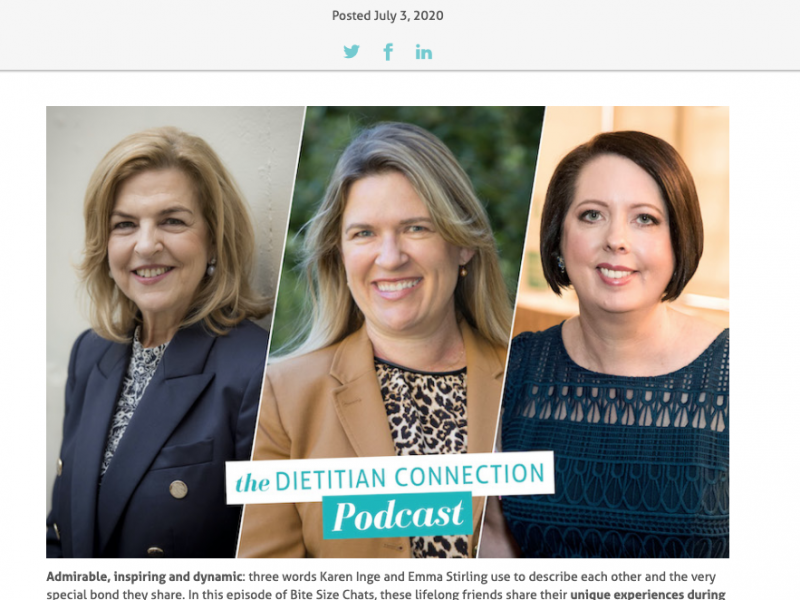With great eagerness and anticipation the wait is nearly over. After nine long years, the National Health and Medical Research Council (NHMRC) is updating the Australian Dietary Guidelines and a draft has been open for public comment since the 13th of December 2011. A colossal amount of work has been put into reviewing the latest scientific evidence (over 55,00 journals) and expert opinion. Our Sub of the Month has reviewed some major changes. And caught up with some leading dietitians for their views:
Shae Rickards is the February Sub of the Month and passionate foodie about to commence her Masters of Dietetics course at Deakin University. Connect with her on twitter @shaerick and read her full bio here.
The Australian Dietary Guidelines are incredibly important as they underpin our approaches to good health. They provide information about the types and amounts of foods, food groups and dietary patterns to assist in the prevention of diet-related chronic diseases, and improve the health and wellbeing of the Australian community. Different quantities of different types of foods from the food groups are recommended for different ages, sexes, and those with different energy intake requirements.
The Guidelines are utilised by health professionals, policy makers, educators, food manufacturers, food retailers and researchers – who can then guide Australian’s with healthy eating. The Guidelines are intended for people of all ages and backgrounds in the general healthy population, including people with common diet-related risk factors such as being overweight. They do not apply to people with medical conditions requiring specialised dietary advice, nor to the frail and elderly who are at risk of malnutrition.
We looked at some of the major changes in the new draft Dietary Guidelines:
What’s new? Vegetables and legumes/beans
Emphasis on different types and colours i.e. Brassica/cruciferous, orange, green,
Legumes/ beans have been added
Vegetables have been separated from fruits
Accredited Practising Dietitian and blogger, Jemma O’Hanlon says, “It’s great that the new guidelines are emphasising loads of colour. I’m always encouraging people to be creative with how they prepare vegetables and think outside the steam box. The right cooking tips are vital to help people fall in love with vegetables”.
What’s new? Grain (cereal) foods
Food group is now called grains instead of cereals
Removed the recommendation to “Eat plenty”
Changed the importance of wholegrain from “preferably” to “mostly”
Expanded grain choices e.g. polenta, couscous, oats, quinoa, barley in part to reflect our cultural diversity.
Serve sizes have been condensed e.g. bread (2 to 1 slice), rice and pasta (1 cup to half cup), flour (1/3 cup to 1/4 cup)
Accredited Practising Dietitian and media commentator, Dr. Joanna McMillan welcomes the guidelines emphasis on wholegrains. She says, “The growing trend for paleo diets, grain free and/or gluten free has meant many people perceive grain foods as unhealthy. This is not what the evidence shows. Gut health is a big concern in Australia and high fibre diets from consuming wholegrains and legumes is hugely beneficial. I also want people to be active and anyone who exercises knows that carb-rich foods such as these give you the energy you need. Lastly from an environmental perspective we cannot feed the world on high animal produce diets. We have to get many of our nutrients from plant foods. Although there are still things I’d like to improve in the guidelines they are in general a much needed shift on the right direction.”
What’s new? Lean meat and poultry, fish, eggs, nuts and seeds, and legumes/beans
Red meat serves- young women to increase intake while adult men to decrease intake
Serve sizes have been altered e.g. meat (65g from 65-100g), legumes (80 to 170g)
Legumes have been added as a meat alternative for vegetarians
Accredited Practising Dietitian and author of Lose Weight Fast, Susie Burrell supports the need for young women in general to eat more, lean red meat. She says, “Recent research has shown that at least 30% of teenage girls had low iron stores which can cause extreme fatigue, an inability to concentrate and low energy. While vegetarians have often adapted to absorb the iron they require from non-meat foods, sporadic meat consumption, particularly by teenage girls and young women, can easily lead to lowered iron stores”.
What’s new? Milk, yoghurt, cheese/alternatives
Use of “mostly reduced-fat”, rather than “reduced-fat”
Accredited Practising Dietitian, Matt O’Neill of Metabolic Jumpstart says “Unfortunately, saying ‘mostly’ reduced fat leaves it open for the consumer to decide what consumption ‘mostly’ equals. Like “drink in moderation” let’s people overestimate what moderate alcohol drinking is, the change in words could result in some people consuming too much full-fat dairy products, which may increase their calories and saturated fat intake.” Education materials that support the guidelines are vital.
There are other changes too, like the inclusion of alcohol and stronger recommendation to limit intake of added sugars i.e. from “consume only moderate amount” to “limit intake of foods and drinks containing added sugars”. Overall, I believe the NHMRC have done a brilliant job in a very challenging area. They’ve been able to provide both practical and scientific advice which can be applied to improve the health and nutrition of our country. But I expect there will be ongoing fierce debate. I would say to anyone with an opinion, act fast! Your say counts and individual submissions are welcome. Submissions close today, 29th February 2012.
Editor’s comment:
Thanks Shae. It’s been so great having you on board this month. We wish you great success in your studies ahead. One thing I love about the new draft is the better focus on foods not nutrients and that the images of real foods and not illustrations will be used to show the food groups. I bet many of our colleagues and readers have their views and questions too? Love to hear in the comments below.



